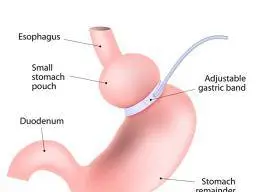Contents
Gastric Band
Surgical technique to lose weight, the gastric band or gastroplasty consists in reducing the volume of the stomach using a ring of adjustable diameter. It is part of the so-called pure restrictive obesity surgery techniques.
What is the gastric band?
Gastroplasty involves putting a ring around the stomach to reduce its size. The ring is placed around the upper part of the stomach, thus delimiting a small pocket called a “gastric pocket”. Few food is enough to fill it, the feeling of satiety therefore appears quickly, thus reducing food intake. It is on this principle that the expected weight loss is based.
The diameter of the gastric band is adjustable thanks to a silicone tube connecting it to a subcutaneous control box. The ring can be tightened or loosened by injecting liquid into the case, through the skin.
Unlike sleeve or gastrectomy (operation consisting in removing part of the stomach) and by-pass (technique consisting in reducing and assimilating food, thanks to a short-circuit of part of the stomach and of the intestine), the gastric band has the advantage of being reversible. Unlike the by-pass, it does not lead to nutrient malabsorption, so the risk of dietary deficiencies is reduced.
How is the gastric band fitted?
Before the operation
A preparatory phase of several months systematically precedes the operation. The patient meets various specialists (surgeon, nutritionist, dietitian, psychiatrist or psychologist, anesthesiologist, etc.) and undergoes various examinations: blood tests, esogastroduodenal endoscopy, x-rays, evaluation of respiratory and cardiac function, pregnancy test, oral evaluation … The purpose of this health check is to detect possible pathologies (nutritional or vitamin deficiencies, diabetes, arterial hypertension, hypercholesterolemia, cardiac disorders, sleep apnea syndrome or other respiratory disorders, joint disorders). Added to this is a review of eating habits and physical activity. Even before the operation, it is indeed important to change your eating habits and to think about an adapted physical activity. The multidisciplinary team can support the patient in these steps. Finally, a psychological assessment is carried out with, if necessary, support from a psychotherapist.
At the end of this preparatory phase, the medical team delivers its opinion:
- the intervention is possible, a date of intervention is decided;
- the preparation is not sufficient, a new opinion will be issued after an additional preparation phase
- intervention is not possible.
The intervention
The operation takes place under general anesthesia, generally by laparoscopy, more rarely by laparotomy (incision of the abdomen). It lasts about 1 hour.
Who is the gastric band for?
Obesity surgery is intended for adults suffering from massive (BMI ≥ 40) or severe obesity (BMI ≥ 35) associated with at least one complication that can be improved with surgery (diabetes, hypertension, sleep, joint disorders…).
Patients must also meet certain criteria:
- have tried, without success, to lose weight thanks to multidisciplinary medical care (dietetic monitoring, physical activity, psychological care) over several months;
- not present any contraindications to surgery or general anesthesia.
After the operation
Operative suites
Hospitalization lasts 2 to 3 days, a minimum sick leave of 2 weeks is prescribed. Analgesics are prescribed to relieve pain.
Diet after a gastric band
The first days after the operation, the food should be liquid, then in the form of puree. Gradually, a solid diet can be reintroduced with new eating habits, however, to be kept for life:
- ingest small amounts with each meal;
- chew well;
- do not snack between meals;
- stop eating as soon as you feel full;
- avoid drinking during meals.
The expected results
The loss is rapid the first months, maximum after 12 to 18 months, then it slows down. The expected loss is about 40 to 60% of the excess weight, that is to say a weight loss of about 20 to 30 kg for a person of 1 m with a BMI of 70. With this weight loss, the conditions linked to overweight should logically regress.
Lifelong follow-up
Indispensable after obesity surgery, this follow-up is carried out by the multidisciplinary team, in conjunction with the attending physician, at a rate of at least 4 consultations the first year with a member of the multidisciplinary team then at least 1 consultation per year . This follow-up has different objectives: to assess weight loss, to monitor the general state of health and to take charge of any complications or nutritional deficiencies, to assess the psychological state of the person, to ensure that he is following his new habits. food and physical activity, etc. Personal commitment is indeed very important in the success of the intervention.
The risks of complications
The gastric band is an intervention which is not without risks. Complications can occur even several years after the operation:
- problems related to the housing: displacement under the skin, pain, infection, rupture of the tube;
- a sliding of the ring causing dilation of the gastric pouch, which may itself lead to vomiting;
- esophageal disorders (reflux, esophagitis, etc.);
- damage to the stomach caused by the ring.
If there is a complication, the ring can be removed during a new operation. It can also be withdrawn in case of ineffectiveness or at the request of the patient.










